
- •Brian Carl Morgan, Doctor of Philosophy, 2006
- •1. Introduction
- •Introduction
- •Passive Techniques
- •Active Techniques
- •Thesis Objectives and Structure
- •Chapter 2: gray-scale technology
- •Introduction
- •Gray-scale Background
- •Theoretical Background
- •Optical Mask Constraints
- •Standard Lithography Process
- •Design and Lithography Advancements
- •Minimum Feature Limitations
- •2.3.3. Double Exposures
- •Pattern Transfer
- •Deep Reactive Ion Etching (drie)
- •Selectivity Characterizations
- •Technology Collaborations
- •Phase Fresnel Lens (nasa)
- •2.5.2.1. Compensated Aspect Ratio Dependent Etching (carde)
- •Conclusion
- •Chapter 3: elect rostatic comb-drives using goay-scale technology
- •Introduction
- •Electrostatic Actuation Fundamentals
- •Tailored Comb-finger Design and Simulation
- •Analytical Displacement Simulations (2-d)
- •Finite Element Analysis (3-d)
- •Instability Considerations
- •Reduced Height Suspensions
- •Fabrication
- •Comb-drive Testing
- •Reduced Height Comb-fingers
- •Conclusion
- •Introduction
- •Tunable mems Resonator Operation
- •1. Introduction 1
- •1.1. Introduction 1
- •2.1. Introduction 11
- •3.1. Introduction 36
- •4.1. Introduction 51
- •Gray-scale Electrostatic Springs
- •Testing and Characterization
- •Conclusion
- •Introduction
- •Device Concept
- •Figure 5.5: Calculated coupling as two co-axial single-mode fibers are separated longitudinally.
- •Figure 5.6: Alignment schematic for a bent fiber cantilever coupling to a fixed output fiber.
- •Alignment Wedges
- •Fabrication
- •Assembly
- •Actuation Concept Demonstration
- •Introduction
- •Experimental Setup
- •Static Testing
- •Table 6.3: Measured fiber locations for discrete actuation voltages. These 4 points form the corners of a diamond shaped alignment area.
- •Channel a (va2)
- •1. Introduction 1
- •1.1. Introduction 1
- •2.1. Introduction 11
- •3.1. Introduction 36
- •4.1. Introduction 51
- •Horizontal displacement
- •Voltage Squared (v2)
- •Auto-alignment Algorithms
- •Figure 6.16: Simplified hill-climbing algorithm block diagram.
- •Automated Fiber Alignment Results
- •Settling Time, Coarse Threshold Power (%Peak)
- •Testing Summary and Discussion
- •Conclusion
- •Summary of Accomplishments
- •Future Work
Thus,
we can conclude that while the magnitude of fiber separation is
important, active fiber positioning along the axis of transmission
at the sub-micron level is unnecessary. Passive techniques for fiber
placement along this axis can be utilized instead, meaning the
gray-scale fiber aligner can restrict itself to 2-axis
optimization of the more important axial and angular alignment
components. Ultimately, for other devices or applications, the
longitudinal fiber position may be more important than shown here,
but positional requirements should still be more forgiving than
along the other axes.Figure 5.5: Calculated coupling as two co-axial single-mode fibers are separated longitudinally.
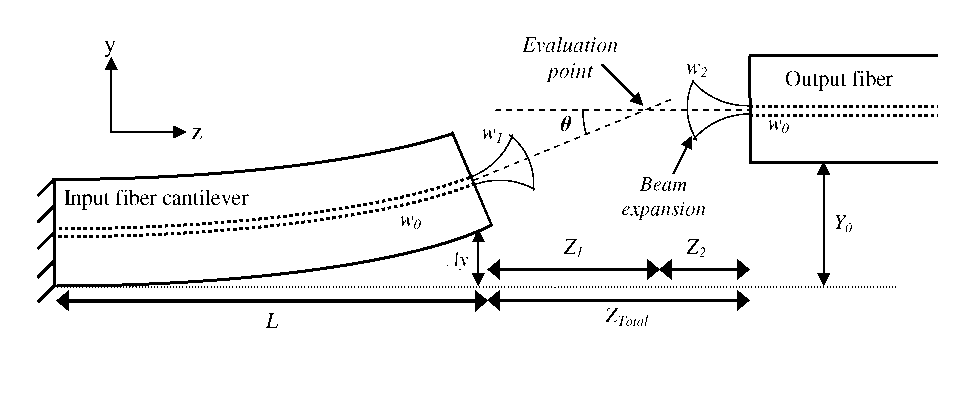
Figure 5.6: Alignment schematic for a bent fiber cantilever coupling to a fixed output fiber.
2
2Ay
The
fiber cantilever length (L) and tip displacement (Ay)
dictate the included angle (0) between the extended propagation
axes of each fiber (see Appendix C):
For such separated fibers with an included angle (0), Joyce and DeLoach were able to show that the transmission (T) can be now be written as [158]:



Pure axial misalignment can be viewed as a special case of Equations 67 and 68, where the included angle becomes infinitesimally small angle (6=d/z as z^»). Thus, as z^», Equation 63 approaches w^2z/kw0 and Equations 67 and 68 reduce to [158]:
As
evident from the figure, the longitudinal loss caused by 30pm
separation essentially causes a vertical shift across the entire
range of tip displacements (0.31 dB). In contrast, the axial loss
changes dramatically with tip deflection, where a 2pm
Figure
5.7: Various loss components for a single target fiber location @
Уй=20цт.
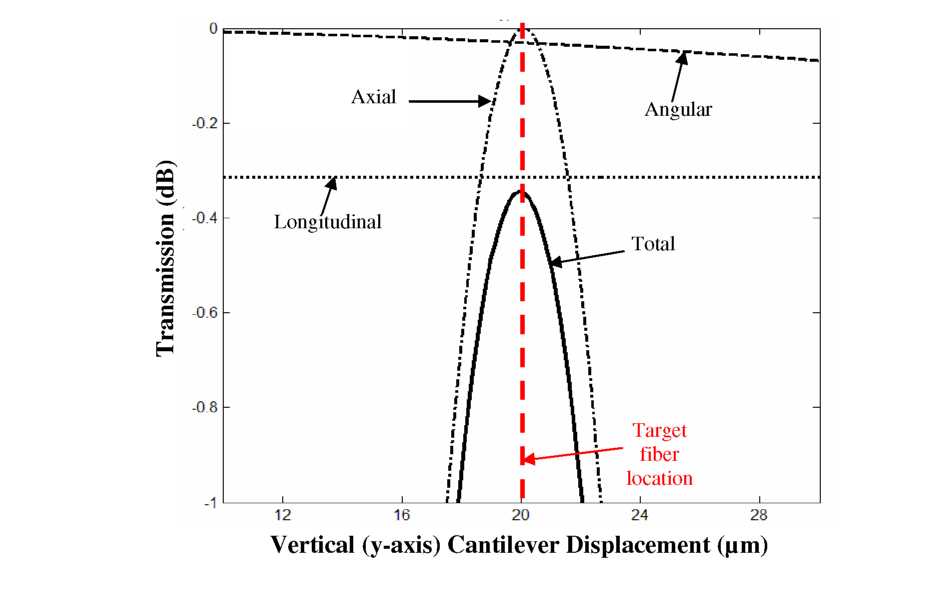 We
will now use Equations 62-69 to simulate the transmitted power (T)
as a function of fiber cantilever tip displacement and analyze the
losses corresponding to each component. Shown in Figure 5.7 is the
transmitted power for a cantilever (L=5mm)
with various tip deflections. The target fiber location has been
fixed at Y0=20^m
with longitudinal separation of Z=30^m.
Also plotted in Figure 5.7 are lines indicating the loss that would
be caused by each type of misalignment (longitudinal, axial, and
angular) if they occurred independently of the other two. Strictly
speaking, the three loss components are not entirely separable.
However, for the geometries being considered, Figure 5.7
suggests
that (to first order) they can be qualitatively viewed as components
whose sum approximates the loss behavior near the coupling peak.
We
will now use Equations 62-69 to simulate the transmitted power (T)
as a function of fiber cantilever tip displacement and analyze the
losses corresponding to each component. Shown in Figure 5.7 is the
transmitted power for a cantilever (L=5mm)
with various tip deflections. The target fiber location has been
fixed at Y0=20^m
with longitudinal separation of Z=30^m.
Also plotted in Figure 5.7 are lines indicating the loss that would
be caused by each type of misalignment (longitudinal, axial, and
angular) if they occurred independently of the other two. Strictly
speaking, the three loss components are not entirely separable.
However, for the geometries being considered, Figure 5.7
suggests
that (to first order) they can be qualitatively viewed as components
whose sum approximates the loss behavior near the coupling peak.
misalignment should cause >0.5 dB of loss. While the relative sensitivity to axial misalignment should be independent of target location, Figure 5.7 shows that the angular misalignment loss (0.03dB for Y0=20p.m) increases with cantilever tip displacement (increasing 0). Since the gray-scale fiber aligner reduces the amount of axial loss by introducing a small angular loss, the location of the target fiber is extremely important as it dictates the angular loss penalty introduced by the device.
Looking more closely at the angular loss penalty, Figure 5.8 plots the maximum transmission for different fiber cantilever lengths and tip displacements (temporarily assuming no longitudinal separation). For long cantilevers (10mm), the angle created by bending the fiber tip 50pm is still rather small. However, for shorter cantilevers (5mm), the angle resulting from the same displacement is larger (see geometry analysis in Appendix C), leading to more optical loss. For comparison, the loss caused by 1pm pure axial misalignment is also shown.
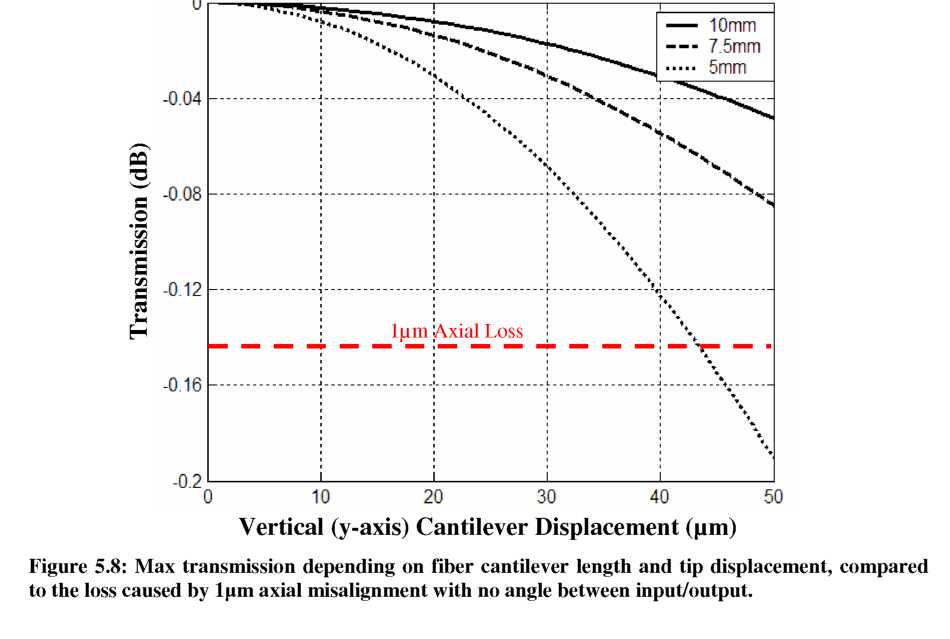
Another way interpret the introduction of angular misalignment is that the axial misalignment must be improved in order to compensate and maintain the same total transmitted power. This concept of angular/axial alignment tradeoffs has been derived analytically in multiple forms as an “alignment product” of angular and axial tolerance terms [158, 159]. Fiber splices requiring high axial resolution are insensitive to angular misalignment, while fiber splices requiring high angular resolution are less sensitive to axial misalignment. As the fiber tip is deflected by the gray-scale fiber aligner, many combinations of angular and axial losses occur. Thus, the power transmission curves for an L=5mm cantilever have been calculated numerically for different target fiber positions to investigate the tradeoff between tip deflection (angle) and required resolution (see Figure 5.9). The loss caused by a 1p,m axial misalignment is also plotted for reference.
As evident in Figure 5.9, target fibers located at large tip deflections have progressively lower peak transmission due to increased angular loss. Thus, axial alignment resolution must improve to <1p,m in order to surpass the equivalent of 1p,m axial misalignment with no tip deflection. Table 5.1 shows the maximum transmission
and axial resolution required to achieve coupling equivalent to a 1pm pure axial misalignment. We see that for a 5mm cantilever and a target fiber at Y0=40^m, the axial resolution must improve from 1pm to 0.40pm to achieve power transmission equivalent to 1pm pure axial misalignment.
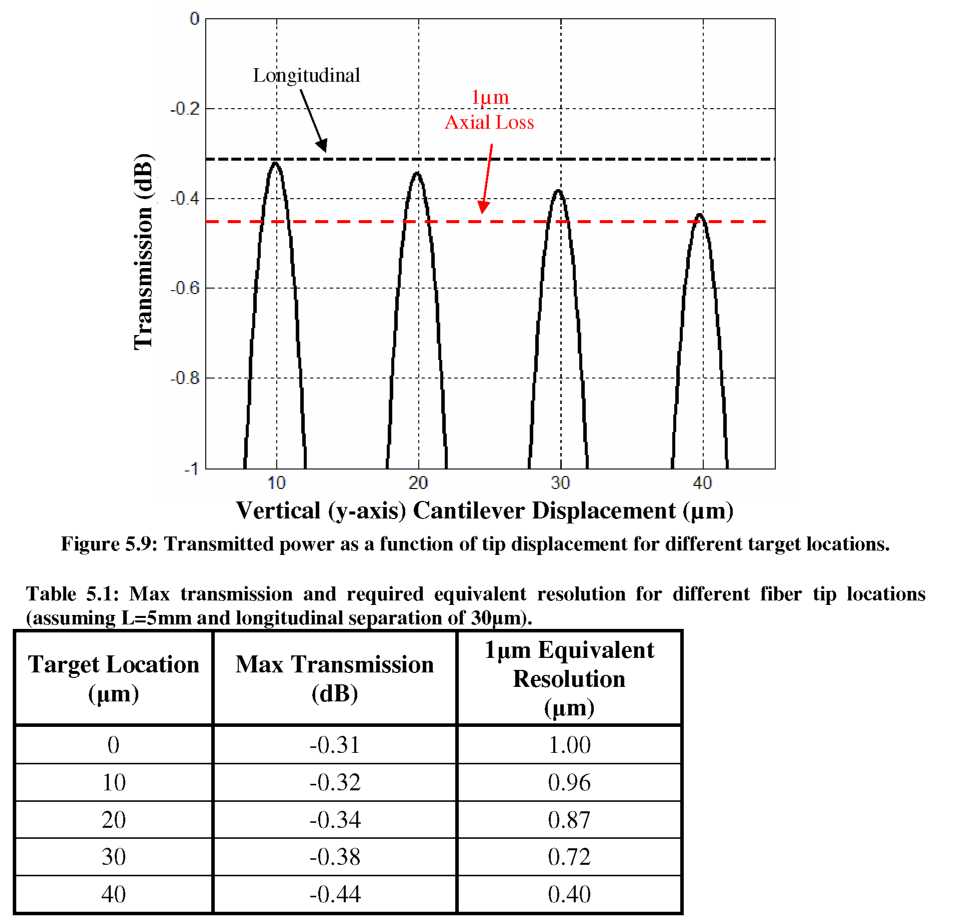
While a 1pm axial loss for cleaved fiber-fiber coupling has been used here for comparison purposes, the tolerances involved will be heavily device and application dependent (e.g. coupling to laser diodes with lensed vs. cleaved fibers has much different tolerances [162]). Most importantly, the preceding coupling analysis serves as a guideline
to estimate limitations of the proposed device. One must use similar analysis to determine what advantage the gray-scale fiber aligner can provide in a specific application.
In this research, to avoid significant angular loss, and for mechanical reasons discussed in the following section, fiber cantilevers with L>i0mm were used. For the lengths and deflections considered here, the radius of curvature for bent fibers is >1m, making bending losses inside the optical fiber negligible.
Design
The principle of operation of an out-of-plane actuator based on opposing sloped alignment wedges was shown previously in Figure 5.1. Translating the alignment wedges alters the location of a cylindrical optical fiber resting within a dynamic v-groove. Since initial embodiments in packaging applications will require only a single use, it is not required that the actuator be either low-voltage or low-power, allowing a large amount of flexibility in actuator design. Planar electrostatic MEMS comb-drives will initially serve as the actuation mechanism for translating the sloped alignment wedges. This enables the use of the same process flow to fabricate both comb-drives and sloped alignment wedges simultaneously. Future devices could integrate variable-height comb-drives for improved displacement resolution, but such improvements lie beyond the initial goals of this thesis. For feasibility in packaging applications, the gray-scale fiber aligner should be capable of compensating for accumulated packaging and assembly errors to the order of 10p,m initial misalignment [152]. The following sections discuss in more detail the design of the actuation mechanism and the design of the opposing sloped alignment wedges.
In-Plane Actuators (Comb-drives)
Design of the in-plane electrostatic MEMS actuator will largely focus on
achieving the desired fiber deflection magnitude. As shown previously in Figure 5.3, the anchor point for the optical fiber provides approximate passive alignment of the optical fiber, similar to a passive v-groove, such that the fiber’s free end rests between the sloped alignment wedges. The location of this anchor point determines the length, and therefore spring constant, of the cylindrical optical fiber cantilever, according to [163]:
3nErA
k fiber = 4i 3 ^72)
where E is Young’s Modulus of the fiber (~70GPa), r is the radius of the fiber (typically r=62.5jum), and l is the length of the fiber cantilever. As an example, a 10mm cantilever results in kfiber= 2.5 N/m. To first order, this spring constant can be modeled as part of the spring constant of the in-plane MEMS actuator suspension.
To achieve a desired range of motion, the actuation mechanism and fiber cantilever length must be considered jointly. Electrostatic comb-drive actuators have well-characterized force behavior, simplifying both design and control. The force generated by a comb-drive was presented earlier in Chapter 3 (Equation 29), and is repeated here:
£ h
F = N -°-V2 (73)
d
where N is the number of comb-fingers, s0 is the permittivity of free space, - is the comb- finger height, d is the gap between fingers, and V is the applied voltage. Making some basic assumptions (N=100, -=100p.m, d=10^m, V=100V), we can estimate a generated force of 89pN. If this force were applied directly to the fiber cantilever discussed above, the deflection would be >35pm (F=kx). However, one must also consider two additional factors for this device: first, the sloped wedges push the fiber at an angle, causing the fiber deflection magnitude to be slightly smaller than the comb-drive deflection (assuming 45° wedges). Second, part of the generated comb-drive force is used to bend the comb-drive suspension, reducing the force delivered to the fiber. However, it is still reasonable to expect fiber actuation on the order of 10’s of micrometers using comb-drive voltages of 100-150V on fiber cantilevers in the range of 10-12mm long. The use of comb-drive actuators also provides interesting possibilities for integrating the gray-scale comb-fingers discussed in Chapter 3 for improved positioning resolution of the fiber.
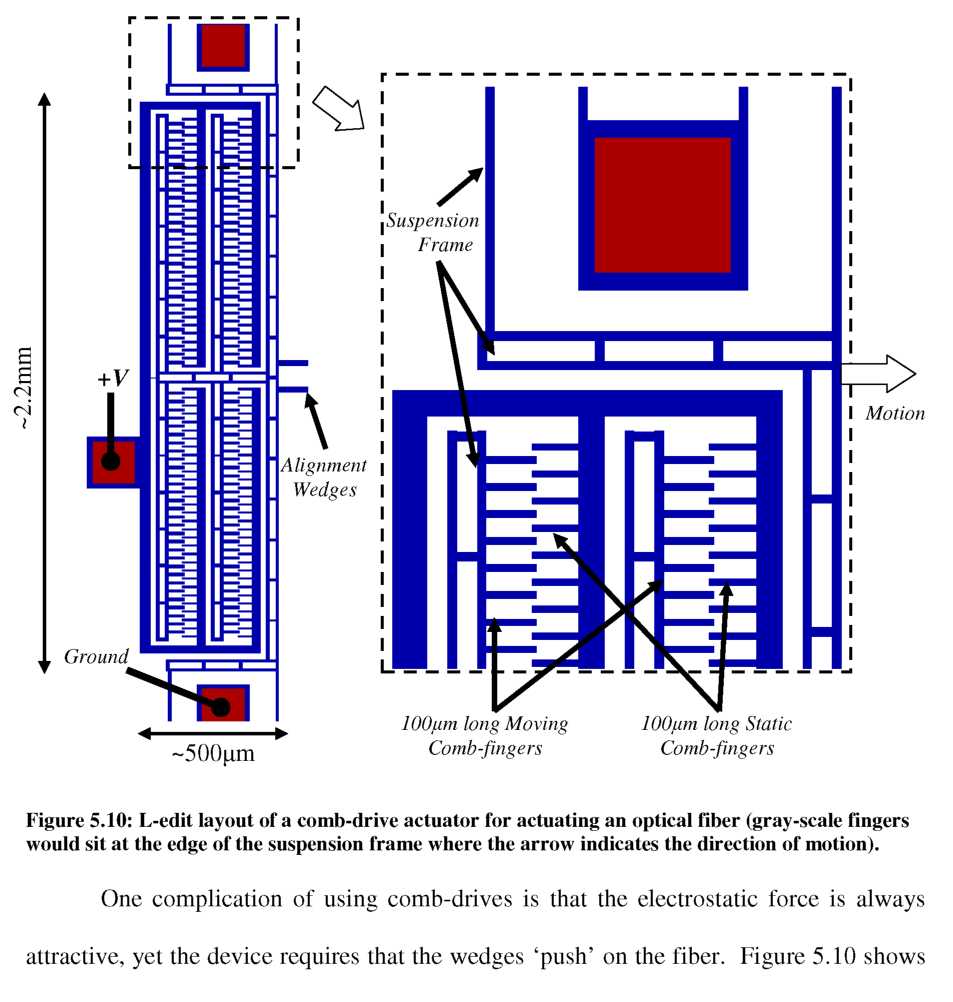
For devices investigating the design, fabrication, operation, and control of this new type of actuator, the relatively large overall footprint is acceptable. However, for packaging applications, it is imperative that these systems be reduced in size, particularly for packaging of fiber arrays with a small pitch (250-500pm). Two primary approaches for developing such systems will be discussed in Chapter 7 as extensions of this work:
the use of reduced cladding fiber (r=40pm) for shorter/more flexible cantilevers, and
integration of higher force actuators that have potentially smaller footprints (such as thermal [45]).
The rest position of a fiber tip between sloped alignment wedges can be calculated using geometry (see Appendix D). We will always assume that the restoring force of the bent fiber cantilever causes it to rest at the bottom of the dynamic v-groove.
